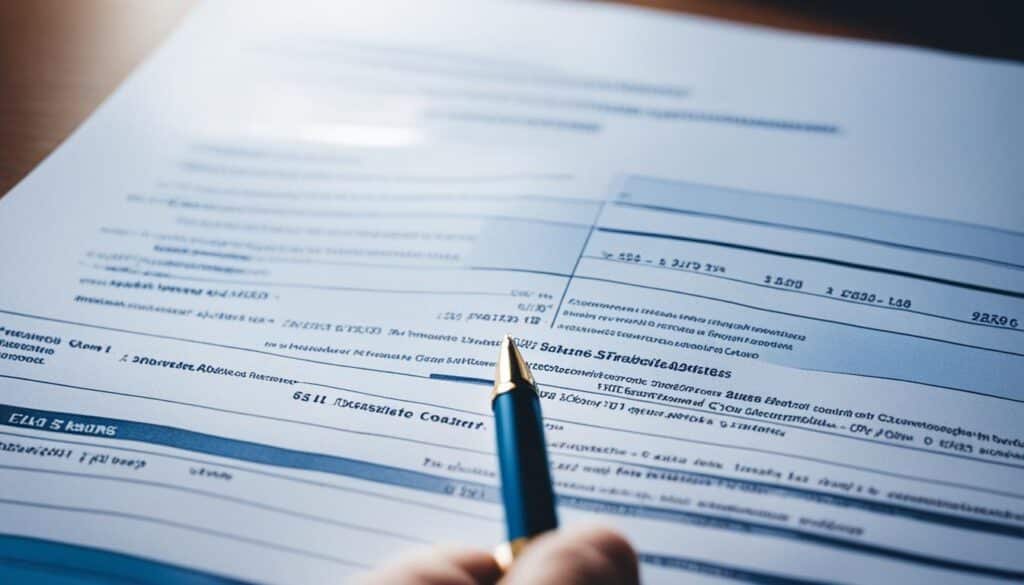Subsidized loans offer an attractive and affordable financing option for eligible borrowers, particularly undergraduate students who demonstrate financial need. These loans are unique in that the federal government pays the interest on the loan while the student is enrolled in school at least half-time, during the grace period after graduation, and during periods of deferment. This can significantly reduce the overall cost of student loan borrowing for undergraduate and graduate students who qualify.
To apply for a subsidized loan, students must complete the Free Application for Federal Student Aid (FAFSA) and demonstrate financial need as determined by their school’s financial aid office. Subsidized loans have annual and aggregate borrowing limits that vary based on factors such as dependency status and year in school, making them a valuable tool for managing the cost of higher education.
Key Takeaways
- Subsidized loans are a need-based federal student loan option where the government pays the interest while the student is in school, during the grace period, and during deferment periods.
- These loans have lower interest rates compared to unsubsidized loans, helping to reduce the overall cost of borrowing for eligible students.
- Subsidized loans are available to both undergraduate and graduate students, with varying annual and aggregate borrowing limits.
- To apply for a subsidized loan, students must complete the FAFSA and demonstrate financial need as determined by their school’s financial aid office.
- Subsidized loans offer flexible repayment options, including income-driven plans, to make the monthly payments more manageable for borrowers.
Subsidized Loan: A Primer
A subsidized loan is a type of federal student loan where the government pays the interest on the loan while the student is enrolled in school at least half-time, during the grace period after graduation, and during periods of deferment. This helps keep the overall cost of the student loan down for the student borrower.
Benefits of Subsidized Loans
The key benefits of subsidized loans include:
- The government pays the interest on the loan while the student is in school, during the grace period, and during deferment periods, reducing the overall cost of the loan.
- Subsidized loans are need-based, so they are available to students who demonstrate financial need as determined by the FAFSA.
- Interest rates on subsidized loans are generally lower than unsubsidized loans and private student loans.
- Subsidized loans offer flexible repayment options, including income-driven repayment plans, to help make the monthly payments manageable for borrowers.
Eligibility for Subsidized Loans
To be eligible for a subsidized loan, students must:
- Be enrolled at least half-time in an eligible degree or certificate program at a school that participates in the federal Direct Loan program.
- Demonstrate financial need as determined by the information provided on the FAFSA.
- Be a U.S. citizen or eligible noncitizen.
- Maintain satisfactory academic progress as defined by their school.
- Not have already reached the maximum lifetime limit for subsidized loans, which is 150% of the published length of the student’s current educational program.
Types of Subsidized Loans

Direct Subsidized Loans are the most common type of subsidized federal student loan. They are available to undergraduate students who demonstrate financial need. The U.S. Department of Education is the lender, and the loan is part of the William D. Ford Federal Direct Loan Program. Direct Subsidized Loans have annual and aggregate borrowing limits, and the interest rate is set by Congress each year.
Direct Subsidized Loans
Direct Subsidized Loans are the most common type of subsidized federal student loan. They are available to undergraduate students who demonstrate financial need. The U.S. Department of Education is the lender, and the loan is part of the William D. Ford Federal Direct Loan Program. Direct Subsidized Loans have annual and aggregate borrowing limits, and the interest rate is set by Congress each year.
Federal Perkins Loans
Federal Perkins Loans were a discontinued subsidized loan program that provided low-interest loans to undergraduate and graduate students with exceptional financial need. The program ended in 2017, but students who received Perkins Loans prior to that date can continue to repay them. Perkins Loans had a fixed 5% interest rate, and the school was the lender. Eligible students could borrow up to $5,500 per year as an undergraduate or $8,000 per year as a graduate student.
Applying for Subsidized Loans

To apply for a subsidized student loan, students must complete the Free Application for Federal Student Aid (FAFSA) each year. The FAFSA collects information about the student’s and their family’s financial situation, which is used to determine the student’s eligibility for federal aid, including subsidized loans. The FAFSA must be submitted annually, as a student’s financial need can change from year to year.
FAFSA: The Gateway to Federal Aid
The FAFSA is the primary application for accessing federal student aid, including subsidized loans. By completing the FAFSA, students unlock access to a variety of financial assistance options, such as grants, work-study programs, and federal student loans. The information provided on the FAFSA is used to calculate the student’s expected family contribution (EFC), which is a critical factor in determining their eligibility for subsidized loans and other need-based aid.
Demonstrating Financial Need
Subsidized loans are awarded based on financial need, so students must demonstrate that their expected family contribution (EFC) toward the cost of attendance is less than the school’s cost of attendance. The financial aid office at the student’s school uses the FAFSA information to calculate the student’s EFC and determine their eligibility for subsidized loans and other need-based aid. Students with a lower EFC will generally qualify for more subsidized loan funding.
Subsidized Loan Limits and Interest Rates

Borrowing student loans, including subsidized loans, comes with specific limits and interest rates that students should understand. These parameters play a crucial role in managing the overall cost and repayment of educational financing.
Annual and Aggregate Loan Limits
There are annual and aggregate (lifetime) limits on the amount of subsidized loans a student can borrow. For dependent undergraduate students, the annual limit ranges from $3,500 to $5,500, depending on the student’s year in school. The aggregate limit for dependent undergraduates is $23,000. For independent undergraduate students and dependent students whose parents cannot obtain a PLUS loan, the annual limit is $6,000 to $12,500, with an aggregate limit of $57,500. Graduate students are not eligible for subsidized loans.
Understanding Interest Rates
The interest rate on Direct Subsidized Loans is set by Congress each year and is fixed for the life of the loan. For the 2022-2023 academic year, the interest rate is 4.99%. This rate applies to all new Direct Subsidized Loans disbursed on or after July 1, 2022, and before July 1, 2023. Interest rates can change annually, but once a loan is disbursed, the rate remains fixed for the life of that particular loan.
Managing Subsidized Loans

As subsidized loan borrowers navigate the repayment process, they have several options to consider that can help make their monthly payments more manageable. The Standard Repayment Plan offers fixed monthly payments over a 10-year period, while the Graduated Repayment Plan starts with lower payments that gradually increase over time, also within a 10-year timeframe.
Loan Repayment Options
For borrowers seeking greater flexibility, Income-Driven Repayment Plans cap monthly payments at a percentage of the borrower’s discretionary income and provide loan forgiveness after 20 to 25 years of qualifying payments. The Extended Repayment Plan extends the repayment period up to 25 years, with either fixed or graduated monthly payments.
Deferment and Forbearance
Subsidized loan borrowers may also be eligible for deferment or forbearance, which allow them to temporarily postpone or reduce their monthly payments in certain situations, such as returning to school, experiencing economic hardship, or serving in the military. During deferment periods, the government continues to pay the interest on subsidized loans, helping to keep the overall debt from growing. Forbearance periods, on the other hand, do not receive the same interest subsidy.
Subsidized vs. Unsubsidized Loans

The key differences between subsidized and unsubsidized federal student loans are significant. Subsidized loans are need-based, meaning the government pays the interest on the loan while the student is in school, during the grace period, and during deferment periods. In contrast, unsubsidized loans accrue interest from the time of disbursement, which can lead to a higher overall cost for the borrower.
| Feature | Subsidized Loans | Unsubsidized Loans |
|---|---|---|
| Interest Payments | The government pays the interest while the student is in school, during the grace period, and during deferment. | The student is responsible for paying the interest, which accrues from the time of disbursement. |
| Interest Rates | For the 2022-2023 academic year, the interest rate is 4.99%. | For the 2022-2023 academic year, the interest rate is 6.54%. |
| Borrowing Limits | Subsidized loans have annual and aggregate borrowing limits, which can be lower than unsubsidized loans. | Unsubsidized loans have higher annual and aggregate borrowing limits, allowing students to cover more of the cost of attendance. |
| Eligibility | Subsidized loans are awarded based on demonstrated financial need as determined by the FAFSA. | Unsubsidized loans are available to all eligible students regardless of financial need. |
These key differences highlight the importance of understanding the pros and cons of subsidized and unsubsidized loans when making decisions about financing your education. By carefully evaluating your financial situation and exploring all available options, you can make an informed choice that best meets your needs and helps you achieve your educational goals.
Private Subsidized Loan Options

While the majority of subsidized loans are federal student loans, there are a few private lenders that offer their own versions of subsidized loans. These private subsidized loans typically have similar features to federal subsidized loans, such as the government paying the interest while the student is in school. However, private subsidized loans may have different eligibility criteria, interest rates, and repayment terms compared to federal subsidized loans.
Some examples of private lenders offering subsidized loans include Sallie Mae and Wells Fargo. Students should carefully compare the terms and conditions of private subsidized loans to federal subsidized loans to determine the best option for their needs.
| Private Subsidized Loan Lender | Interest Rates | Repayment Terms | Eligibility Criteria |
|---|---|---|---|
| Sallie Mae | Variable rates starting at 3.75% | 10-15 years | Undergraduate and graduate students, U.S. citizens or permanent residents, minimum credit score requirements |
| Wells Fargo | Fixed rates starting at 5.99% | 5-15 years | Undergraduate and graduate students, U.S. citizens or permanent residents, minimum credit score and income requirements |
When considering private subsidized loans, students should carefully evaluate the interest rates, repayment terms, and eligibility criteria to ensure they are getting the best value and fit for their financial needs.
Subsidized Loans for Undergraduate Students

Subsidized loans are available to eligible undergraduate students who demonstrate financial need based on the information provided on the FAFSA. The annual loan limit for dependent undergraduate students ranges from $3,500 to $5,500, depending on the student’s year in school. For independent undergraduate students and dependent students whose parents cannot obtain a PLUS loan, the annual limit is $6,000 to $12,500. The aggregate (lifetime) limit for subsidized loans for undergraduate students is $23,000 for dependent students and $57,500 for independent students.
Eligibility and Limits
To be eligible for subsidized loans, undergraduate students must demonstrate financial need as determined by the FAFSA. The amount they can borrow is subject to annual and aggregate loan limits, which vary based on factors such as dependency status and year in school. Dependent undergraduate students can borrow between $3,500 and $5,500 per year, while independent undergraduates and dependent students whose parents cannot obtain a PLUS loan can borrow between $6,000 and $12,500 annually. The lifetime aggregate limit for subsidized loans is $23,000 for dependent students and $57,500 for independent students.
Responsible Borrowing Strategies
When taking out subsidized loans, it’s important for undergraduate students to borrow only what they need to cover the cost of attendance and to explore other sources of financial aid, such as scholarships and grants, before relying on student loans. Students should also consider ways to reduce their overall borrowing, such as living frugally, working part-time, and taking advantage of in-state tuition rates if possible. Responsible borrowing can help minimize student loan debt and make repayment more manageable after graduation.
Subsidized Loans for Graduate Students

Subsidized Loan Availability
Graduate students are not eligible for subsidized federal student loans. The subsidized loan program is only available to undergraduate students who demonstrate financial need. However, graduate students may be eligible for unsubsidized federal student loans, which do not require a demonstration of financial need.
Maximizing Financial Aid
To maximize their financial aid options, graduate students should complete the FAFSA each year, even though they are not eligible for subsidized loans. The FAFSA information is used to determine eligibility for other types of federal aid, such as work-study programs, grants, and unsubsidized loans. Graduate students can borrow up to $20,500 per year in unsubsidized loans, with an aggregate limit of $138,500 (including any undergraduate loans).
Graduate students should also explore scholarship opportunities, employer tuition assistance, and other creative ways to fund their education to minimize the need for student loans. By taking advantage of all available financial aid resources, graduate students can work towards their educational goals while managing their student debt responsibly.
Subsidized Loan Forgiveness Programs

Subsidized loans can provide significant financial relief for eligible borrowers, and there are several forgiveness programs available to help further reduce the debt burden. Two prominent examples are the Teacher Loan Forgiveness program and the Public Service Loan Forgiveness (PSLF) program.
Teacher Loan Forgiveness
The Teacher Loan Forgiveness program allows eligible teachers who teach full-time for five consecutive years in low-income schools or educational service agencies to have up to $17,500 of their subsidized and unsubsidized federal student loans forgiven. To qualify, teachers must meet specific criteria related to their subject area, certification, and the type of school where they teach.
Public Service Loan Forgiveness
The Public Service Loan Forgiveness (PSLF) program provides forgiveness for the remaining balance on eligible federal student loans, including subsidized and unsubsidized loans, for borrowers who work full-time in public service jobs and make 120 qualifying monthly payments. Eligible employers include government organizations, non-profit organizations, and certain types of private not-for-profit organizations.
Also Read : American Express Personal Loan Get Funding Now
Conclusion
Subsidized loans can be a valuable resource for undergraduate students who demonstrate financial need, as the government covers the interest on these loans while the student is enrolled in school and during certain deferment periods. By understanding the eligibility requirements, borrowing limits, interest rates, and repayment options associated with subsidized loans, students can make informed decisions about financing their education and minimizing their overall student debt.
Additionally, subsidized loan forgiveness programs, such as the Teacher Loan Forgiveness program and the Public Service Loan Forgiveness (PSLF) program, can provide further financial relief for eligible borrowers. By exploring all available options and borrowing responsibly, students can maximize the benefits of subsidized loans to make their education more affordable.
Overall, subsidized loans offer an attractive financing solution for undergraduate students who qualify based on their demonstrated financial need. By carefully navigating the subsidized loan process and leveraging additional opportunities for loan forgiveness, students can effectively manage their educational expenses and set themselves up for long-term financial success.
FAQs
Q: What is a subsidized student loan?
A: A subsidized student loan is a type of federal student loan where the government pays the interest while the borrower is in school, during grace periods, and deferment periods.
Q: What is the difference between subsidized and unsubsidized student loans?
A: Subsidized student loans are need-based, and the government pays the interest while the borrower is in school. Unsubsidized student loans accrue interest while the borrower is in school.
Q: How can I qualify for a subsidized student loan?
A: To qualify for a subsidized student loan, you must demonstrate financial need as determined by the Free Application for Federal Student Aid (FAFSA).
Q: What are the pros and cons of subsidized loans?
A: Pros of subsidized loans include the government paying the interest while you are in school. Cons may include borrowing limits and eligibility criteria based on financial need.
Q: What is a federal direct loan?
A: A federal direct loan is a type of loan where the US Department of Education is the lender. It includes both direct subsidized and direct unsubsidized loans.
Q: How do I contact my loan servicer?
A: You can contact your loan servicer by visiting the Federal Student Aid website or by calling the phone number provided on your loan documents.
Q: Can I defer my subsidized loan payments?
A: Yes, you may be eligible to defer your subsidized loan payments if you meet certain criteria such as being enrolled at least half-time in school or experiencing economic hardship.
Q: What are federal direct subsidized and unsubsidized loans?
A: Federal direct subsidized and unsubsidized loans are financial aid options provided by the government to help students pay for higher education. The key difference is that with subsidized loans, the government pays the interest while the student is in school, whereas with unsubsidized loans, the student is responsible for all interest accrued.
Q: How do I qualify for a subsidized loan?
A: To qualify for a subsidized loan, you must demonstrate financial need. This is determined by your Free Application for Federal Student Aid (FAFSA) form, which helps determine your eligibility for various types of financial aid.
Q: Can I receive direct subsidized loans as a graduate or professional student?
A: Unfortunately, direct subsidized loans are only available for undergraduate students with financial need. Graduate and professional students are eligible for direct unsubsidized loans instead.
Q: What is the difference between subsidized and unsubsidized loans?
A: The main difference is how interest accrues on the loan. With subsidized loans, the government covers the interest while the student is in school and during certain other periods. Unsubsidized loans, on the other hand, accrue interest that the student is responsible for paying.
Q: How much can I borrow with a direct unsubsidized loan?
A: The loan amount you can receive with a direct unsubsidized loan depends on your grade level and whether you are considered a dependent or independent student. The maximum amount is set by the government each year.
Q: Can I switch from subsidized to unsubsidized loans or vice versa?
A: Yes, you can switch between subsidized and unsubsidized loans at any time by contacting your loan servicer. Keep in mind that switching loan types may have implications for your interest rate and repayment terms.
Q: What is loan deferment?
A: Loan deferment is a period during which you are not required to make payments on your loan, typically due to specific circumstances such as returning to school, financial hardship, or active military duty. During deferment, interest on subsidized loans may be covered by the government.





